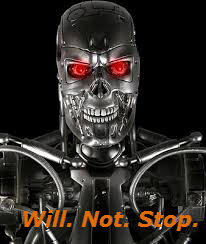Is your story good enough?
In fact… you’ve probably been exploring and sweating to make your protagonist more real, more dynamic, and the supporting cast just as compelling as you need. But, could it be that what you aren’t getting the most out of isn’t the good guys, it’s the bad ones?
(The Unified Writing Field Theory — searchings and findings on what makes stories work)
Villains can be frustrating folks to write, with so many of them already out there to make your idea seem unoriginal, if the word itself doesn’t sound cliché to you. Or you might think you’ve got a brilliant villain concept, but wonder if you’re making full use of it.
Well, I know I’m not pushing my villains to the limit, and most other writers aren’t either. But then, I’m not sure villains have a limit.
If “story = conflict,” that can make the opposition a whopping half of the tale’s very nature. The hero’s struggle may be at the center, but the villain is the root of it all, often the one who created the crisis in the first place. Neglect the villain and the hero has more and more moments when he’s struggling against empty air.
A story is no stronger than its hero, or its villain – whichever is weaker.
Click To Tweet - Powered By CoSchedule
(And let’s face it, a good villain stays with the reader. Heroes need to not be “boring,” but they’ve usually got a relatable balance of issues they’re sorting out over time. But the villain’s liable to make a choice and then “watch the world burn.”)
Image may be NSFW.
Clik here to view.
—Or your writing could be going for a different kind of conflict than Heath Ledger’s Joker. Still, every moment of human conflict can learn a few things from what we call villains. A protagonist still needs major obstacles, whether they’re “bad” people or well-meaning ones; and whatever’s making those people problems ought to be key parts of the story.
All in all, maximizing a #villain is just: write him more like a human being.
Click To Tweet - Powered By CoSchedule
(Except for tone, most of the time. We’ll get to that.)
How human? Hold onto your keyboard, it’s going to be a bumpy night:
Coming to the Dark Side
None of us want to write someone who’s “just a villain.”
—Okay, some writers do, and it can be downright liberating. But if you do, keep reading: a bit of the same balance can still strengthen them.
But: have you really given your villain enough of a reason for what he does? Could you push him harder? One good measure is K.M. Weiland’s challenge that “Maybe your bad guy is right.” Myself, I think it all comes down to, based on what the reader learns,
“How much would a person like this just NEED to get in the way?” #Villains
Click To Tweet - Powered By CoSchedule
Of course, “in the way” might mean anything from blowing up the world to a by-the-books teacher who won’t give a student an inch of slack. But whatever they’re creating that conflict about, what these people need is to make that motivation and its ties to the conflict utterly clear. Remember that marvelous Terminator line:
It can’t be bargained with. It can’t be reasoned with. It doesn’t feel pity, or remorse, or fear. And it absolutely will not stop, ever, until you are dead.
Image may be NSFW.
Clik here to view.
If you can give a human antagonist some of that momentum, for human reasons, you magnify everything about the villain. Which magnifies the whole story.
What are those human reasons? You’re probably got your idea there already, so I’ll settle for mentioning my Sith/ Seven Deadly Sins breakdown and my Thunderbolt Ross question as a starting point (is it what he wants to take from the hero, or what he’s afraid the hero will take?).
So what reveals those reasons? It’s usually how well the backstory, the evolving plot, or at least the story’s situation shows this person HAS to do what he’s doing. Possibly the best way is to plot in the way he might be fulfilling his goals without making trouble (bonus points if it’s as a friend of the hero, of course)… and the perfect chance to make that work… and it goes utterly wrong. You also want to choose a balance between the sense of a harsh world that makes that “fall” seem like something that could happen to anyone, and the intensity in this character that shows he’s better than most would be at embracing his fall—if it wasn’t a leap.
Keep asking that question: would this person NEED to get in the way? (The words you’re looking for are “Hell yes!!”)
Darker and Deeper
Once you put the villain on his path… is that enough?
Part of it is “narrowing” that path, finding ways to show that this villain isn’t out to do whatever “bad things” are available, he wants what he wants—meaning, what chances to do damage can he pass up because they aren’t in his interest? The more you show what things he’ll pause for, the less cliché he is and the more you’ve reinforced that the rest is where he will not stop.
(At least, he won’t stop for long. Some of the best villain “falls” happen in the middle of the story, with his missed chances to turn back happening at the height of everything else.)
All this means giving the villain chances to let people live, to clash with his lieutenants, whatever it may be—maybe because it doesn’t fit his plan, or sometimes even because he does have his softer side or other motives as well. It also means surprising the hero (or at least some less villain-savvy friends) with twists where the villain passes up one target to go after another, probably a nastier one. (If you were thinking that The Dark Knight seemed to ignore the last section’s tips about justifying the villain, you’re right. We never learned what made the Joker, but instead the whole movie used this method to demonstrate in detail just what he was.)
To really show things off, try letting the villain do good now and then, maybe allying with the hero if there’s something they both need gone. (“He can’t destroy the world, I need to rule it!” is always fun.) And of course the hero should be spotlighting the villain’s nature too, with every scene where he tries to predict, trick, frighten and generally outwit his enemy. (I’ve analyzed a few ways to do that.)
In fact… could the villain change? Star Wars and many other tales turned out to be about redeeming their villain. Or he could give up his evil world-view for a different and even more vicious one. (In its most overused form, “If I can’t have her…”)
Villains may be implacable at the right moments, but they need a sense of precision and even change as well. Because they aren’t forces of nature, each is something much more terrifying: a human being who’s actively looking for ways to get you.
Note that word, “actively.” That’s the next question for maximizing a villain: are the hero—or you—taking them for granted?
Continued next week.
On Google+
Clik here to view.
